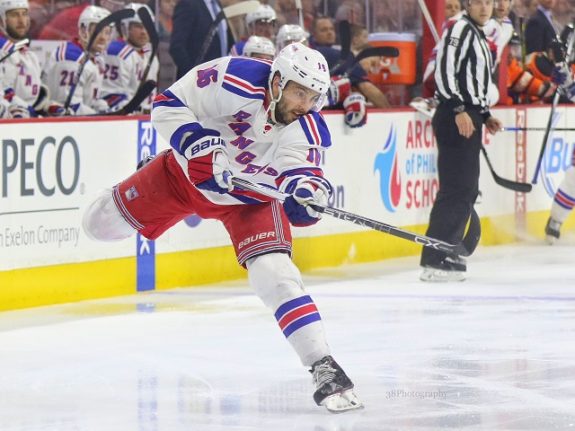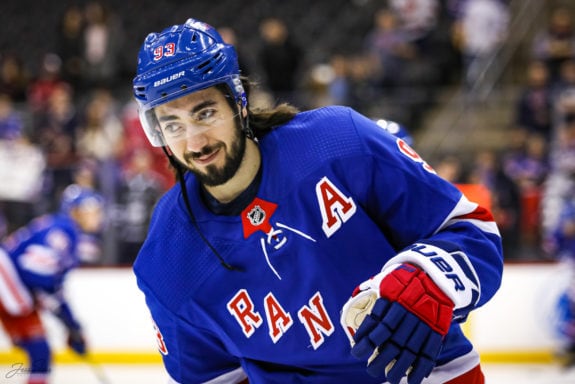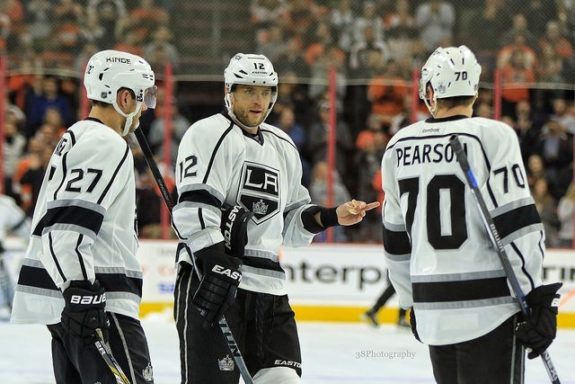
 Cameron Thompson
The Hockey Writers
Cameron Thompson
The Hockey Writers
47
Reads
0
Comments
Blue Jackets Roster Impact From the Gaborik Trades
Since breaking into the National Hockey League in the 2000-01 season after being selected third overall in 2000 by the new expansion franchise, the Minnesota Wild, the hockey world knew that the Slovak forward Marian Gaborik could leave his mark with the Wild and the NHL.
20 years later, no one could have expected the impact the 38-year-old Gaborik would have, not even with the Wild, but on a number of different teams’ directions and roster makeups like the Los Angeles Kings, New York Rangers and Columbus Blue Jackets.
Related: The First Jeff Carter Trade Revisited
This is not to say that Gaborik didn’t have an impact with the Wild, because he certainly did in taking the club to the postseason in three of the eight years in Minnesota as well as being seen as one of the best forwards to ever play for the professional hockey team in the State of Hockey.
No postseason memory stood out more than in 2003 where Gaborik posted 17 points in 18 games en route to an unfortunate Western Conference Final sweep by the eventual Stanley Cup runner-ups in the Mighty Ducks of Anaheim.

The impact on the NHL for Gaborik started with a decision to sign with the New York Rangers in free agency on July 2, 2009, with a five-year, $37.5 million deal making $7.5 million per season.
In his first three seasons with the New York Rangers, Gaborik had two seasons of 40 goals or more and two seasons of 70 points or more with one season at a career-high point total of 86 and an Eastern Conference Final appearance in 2012 against the New Jersey Devils.
Related: Top 5 Greatest Stanley Cup Playoff Upsets
In the fourth year of his contract, Gaborik was traded to the Blue Jackets, thus starting an interesting and complicated trade tree that affected the Rangers, Blue Jackets, Kings, and the NHL in many different ways, starting with that trade.
Gaborik to the Blue Jackets
On April 3, 2013, the Rangers traded the 31-year-old star forward, plus Blake Parlett and Steven Delisle to the Blue Jackets in exchange for Derick Brassard, Derek Dorsett, John Moore and a conditional sixth-round pick in 2014.
| Going to Columbus | Going to New York |
| Marian Gaborik | Derick Brassard |
| Blake Parlett | Derek Dorsett |
| Steven Delisle | John Moore |
| 2014 sixth-round pick (#167 – Chase Lang) |
The deal sent shock waves around the NHL and was the first big deal from the newly hired European GM of the Blue Jackets, Jarmo Kekalainen. It was a gamble by Kekalainen to take advantage of the Blue Jackets’ momentum in a lockout-shortened season to inch into the playoffs just the second time in franchise history.
Unfortunately for the Blue Jackets, Gaborik’s time in union blue was short-lived and filled with injuries, and he was traded to the Kings at the 2014 trade deadline. Gaborik’s numbers with the Blue Jackets were 22 points in 34 games.
Related: 2015 NHL Draft Top 10 – Where Are They Now?
On the other hand, the Rangers felt Gaborik could fetch some value at the trade deadline and the hunch didn’t disappoint. The Rangers received a 26-year-old talented and dependable scoring center entering his prime in Brassard, a third or fourth-line presence with an evolving, but fluctuating scoring touch in Dorsett and a first-round talent and potential top-four defenseman in John Moore as well as a conditional pick.

The biggest thing that the Rangers could take from the potential pieces received in the Gaborik trade was undoubtedly Brassard as he quickly blossomed as a playoff performer for the Blue Shirts, with 44 points in 59 playoff games in just four seasons.
Payoffs didn’t just stop there for the Rangers, as Brassard was later flipped to the Senators in a 2016 offseason trade for forward Mika Zibanejad. Now, with a dynamic offensive catalyst in Artemi Panarin, as well as Zibanejad coming into his own, the Rangers now have an outstanding one-two punch for years to come.

Gaborik coming to the Blue Jackets initially was an exciting move for a player that had scored 40 goals or more on multiple occasions and could be seen as an offensive driver in play, but the payoff for the Blue Jackets didn’t come until after the trade that sent him out west to Southern California.
Gaborik to the Kings
On March 5, 2014, Gaborik was traded by the Blue Jackets to the Kings for Matt Frattin, a 2015 second-round pick and a 2014 third-round pick, effectively ending Marian’s short tenure with the Blue Jackets in just 34 games.
| Going to Columbus | Going to Los Angeles |
| Matt Frattin | Marian Gaborik |
| 2015 second-round pick (#34 – Travis Dermott) | |
| 2014 third-round pick (#63 – Dominic Turgeon) |
Columbus ended up cutting its losses with Gaborik and got significantly less value than what it gave up to get him in just one year prior. Frattin was a third or fourth-line player at the NHL, even if there was some upside with the Toronto Marlies of the AHL. The draft picks were a nice touch, but nowhere near the value of a multiple 40-goal
Related: Worst Trades in Oilers History
As fate would have it, Gaborik would catch fire down the stretch and into the playoffs as a top deadline acquisition for the Kings resulting in a 2014 Stanley Cup championship over the New York Rangers in five games. Gaborik somehow managed to beat two of his former NHL teams in one moment as he lifted the Stanley Cup over his head.

After an impressive postseason with 14 goals, one shy of Wayne Gretzky’s postseason franchise record, Gaborik signed a seven-year deal that would pay him $4.875 million per season. At that point, that is when Gaborik’s career started to decline with injuries being a major factor.
In just the four years into his new seven-year deal, on February 13, 2018, Gaborik was traded to the Ottawa Senators in a deal that sent Dion Phaneuf to the Kings. Gaborik’s continually ailing injuries have put his career at a full stop with retirement on the horizon or a possible buyout, but perhaps LTIR is best served until his contract runs out after the 2020-21 season.
Impact on Future Rosters
Looking back on both of the trades from the Blue Jackets’ perspective, one can come to the easy conclusion that they lost both trades badly and that would be correct. However, it is what you do with the value that you get back, the value that you have, and how creative you are willing to be as a general manager.
The Rangers made great trades and displayed excellent asset management with their pieces from the Gaborik deal. They got a huge piece to their future in Zibanejad. Prior to that on March 1, 2015, they traded John Moore and Anthony Duclair to Arizona for Keith Yandle. Then, they flipped Yandle’s rights to Florida for a draft pick that the Rangers would use to select a towering and blooming defenseman from the University of Wisconsin in K’Andre Miller.
Related: Jarmo Kekalainen’s Third-Round Picks Ranked
Columbus didn’t have the luxury to get good value back from the trades, because the value of Gaborik diminished so quickly and it had to rely on accumulating picks through the draft and use assets from different deals to bring in other assets.
The assets that the Blue Jackets recouped in the Gaborik deal with the Kings was a 2015 second-round pick (#34 – Travis Dermott) and the 2014 third-round pick (#63 – Dominic Turgeon). Each pick was used to get a player through the draft or through trade in some way.
The 2014 third-round pick was traded to the Detroit Red Wings on June 28, 2014, for a 2014 third-round pick (#76 – Elvis Merzlikins) and a 2015 third-round pick (#80 – Brent Gates). That helped the Red Wings trade up to select Dominic Turgeon while the Jackets selected Merzlikins, who is turning out to be quite the goaltender in Columbus.

Then, on March 2, 2015, the Blue Jackets included the 2015 third-round pick and James Wisniewski to Anaheim for Rene Bourque, William Karlsson and a 2015 second-round pick that the Jackets would use to take Kevin Stenlund, a bright young prospect for Columbus, while Anaheim took Brent Gates with the 80th overall pick.
Another move that the Blue Jackets made was trading into the first round of the 2015 NHL Draft to take Gabriel Carlsson at the 29th

Carlsson came over from the Swedish Hockey League’s Linkopings HC in the late 2016-17 season and went straight into the Stanley Cup playoffs against the eventual Stanley Cup champion Pittsburgh Penguins. He played key minutes and even turned more heads the following season. However, Carlsson has slowly faded away from the organization’s plans as players like Andrew Peeke and Dean Kukan have leaped Carlsson to crack the blue line.
Managing Asset Value is Key
It is strange that a decision by a player in free agency can start a butterfly effect that can shape different rosters at different times down the road, but that’s the nature of draft picks and players in professional sports leagues.
Whether it is Glen Sather, Dean Lombardi, or Kekalainen, it is always about recouping value. Just because you swung a missed on a previous trade doesn’t mean you can’t take the assets that you received from that deal and hit a home run.

Kekalainen’s strength in drafting is well known, but he got a forward and two picks for Gaborik and managed to get a potential franchise goaltender, a smart, responsible center, and a defenseman that has all the tools to become a top-four defenseman. Even if those players don’t pan out, he still has the creative tools of a GM to fall back on.
The post Blue Jackets Roster Impact From the Gaborik Trades appeared first on The Hockey Writers.
Popular Articles

















































 Blackhawks Chicago
Blackhawks Chicago Panthers Florida
Panthers Florida Penguins Pittsburgh
Penguins Pittsburgh Rangers New York
Rangers New York Avalanche Colorado
Avalanche Colorado Kings Los Angeles
Kings Los Angeles Maple Leafs Toronto
Maple Leafs Toronto Bruins Boston
Bruins Boston Capitals Washington
Capitals Washington Flames Calgary
Flames Calgary Oilers Edmonton
Oilers Edmonton Golden Knights Vegas
Golden Knights Vegas Islanders New York
Islanders New York Sabres Buffalo
Sabres Buffalo Red Wings Detroit
Red Wings Detroit Flyers Philadelphia
Flyers Philadelphia Senators Ottawa
Senators Ottawa Lightning Tampa Bay
Lightning Tampa Bay Devils New Jersey
Devils New Jersey Hurricanes Carolina
Hurricanes Carolina Blue Jackets Columbus
Blue Jackets Columbus Predators Nashville
Predators Nashville Wild Minnesota
Wild Minnesota Blues St. Louis
Blues St. Louis Stars Dallas
Stars Dallas Jets Winnipeg
Jets Winnipeg Mammoth Utah
Mammoth Utah Sharks San Jose
Sharks San Jose Canucks Vancouver
Canucks Vancouver Ducks Anaheim
Ducks Anaheim






